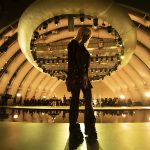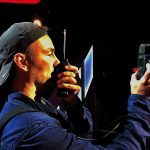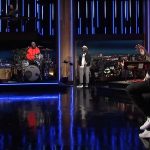Historic TV Facility on Broadway Takes a Modern Lighting Approach
For this month’s Light Night Conversation, the third in PLSN’s series with a focus on late night television talk shows and how they are lit, we chatted with Michael Scricca, LD for The Late Show with Stephen Colbert, and the show’s technical director, Jon Pretnar.

Scricca has been the lighting designer for The Late Show with Stephen Colbert on CBS since the show debuted on September 8, 2015, having previously lit the entire run of The Colbert Report on Comedy Central. Shot in the historic Ed Sullivan Theater, located on Broadway in New York City, Scricca was presented with an impressive architectural space to graze with light, but also had to design a television lighting rig that didn’t get in the way of Colbert being able to see and engage with his studio audience. Scricca’s approach has been to bring a very open and clean look using mainly LED technology.

What were some of the challenges of lighting this show in this space?
Michael Scricca: My primary challenge was found the first day we came into the Ed Sullivan Theater. There were a lot of teasers, flags, and Chimeras. You couldn’t really see the audience through the lights and the cameras. They were all in between the talent and audience. I was standing with Stephen and he said, “Mike, Can we get rid of all this?” I replied, “Funny you should say that. I was thinking I am going to need to strike it all, put up a truss, and light it from as far away as I can.” That was a challenge in the space, but we now have an oval truss that I designed, which Light Action, Inc. fabricated and supplied for me. All the keys are hung between 40 and 60 feet away from Stephen. It’s a nice long throw and he feels more connected to the audience and they have a great view of the show and the theatre as well.
What is a typical day’s schedule?
Scricca: On a typical day, I’m in around 9am. I’m lighting the guest band from 9 to lunch. We will work on the guest band, put out the floor lights, cue the music, lay in the keylights. Then after lunch, we’ll rehearse the show. We’ll go through all of the elements that we’re going to do. We will break while Stephen and the writer are in rewrites, and we will start to shoot at a quarter to six.
Walk us through the layout of the studio in terms of different set-up scenarios you have to address.
Scricca: Home base is Stephen’s desk and the interview area. Then we have, at the center of the stage, a kind of a multi-purpose area. That’s where we’ll do a cooking segment, or we’ll have the guest band play. Camera right we have the house band area for Jon Batiste and Stay Human. There’s also a balcony camera right, where we do the “furry hat” bit. We plan to shoot on the balcony camera left as well.
We also do a lot of bits around the rest of the building. About half the time now, I’m running around the building doing a little film shoot, on the 11th floor or in one of the dressing rooms. It’s like we’re making an independent film; anywhere in the building, at the drop of a hat. In fact, I’m in the process of designing a small studio to shoot green screen bits, office bits, etc., by converting a conference room upstairs. We are putting in a pipe grid, a green screen, a small office and kitchen set there. Then, if we want to do a bit before the show, we can just run up there. It’s going to be a dedicated studio with cameras, lights, and audio, all set to go.

Do you light up the audience for bits?
Scricca: The audience is lit for shoot off, backgrounds mostly, but just today in rehearsal, Stephen ran out into the audience and said, “We’re going to do a bit out here today.” I will be adding more lights so I can be ready to light it as an actual area. I think we’re going to be going out there more, so I want to be prepared.
How does your lighting support the style and the overall look of the show?
Scricca: For the interview area, I would say that my style is interview lighting; an even keylight with a nice strong backlight. For Jon Batiste’s area, right at the beginning, Stephen wanted it to look like a jazz club, so I really I embraced that idea. I started with a nice dark, moody look. From there, I adjusted it to land comfortably in between a real late night jazz club and a brighter TV look.
What are some of your key equipment choices?
Scricca: My key equipment choices are Cineo [Lighting] HS soft lights running at a color temperature of 4,300K, ETC LED Tungsten ellipsoidals that are also tuned to 4,300K, and Arri LED Fresnels, the L5 and L7s. I like the Cineo HS units; they work really well. With some LED units, you have to sacrifice intensity, but not with the Cineo lights. They are easily twice as bright as the conventional alternatives, they are really great lights. I have also put them on Full Frontal with Samantha Bee and Last Week Tonight with John Oliver. [Scricca is LD for both of those shows as well.] Then, for moving lights, I have my [GLP impression] X4s, which I lean on heavily. They are some of the best lights out there.
I am almost all LED now, with the exception of some Martin [MAC] Vipers and Clay Paky Sharpy Washes, which are arc sources. The previous rig in this space was pulling 450 amps per leg, and now the current rig pulls 50 amps per leg. I think LED is much better than conventional on so many levels for television lighting, and I don’t have to worry about the red shift anymore. Now, at Stephen’s desk, I have a fill light that’s running at 15 percent and a keylight that’s running at 90 percent and they’re both exactly the same color temperature. For me, that’s great; my keylights are always going to be the same color temperature. All of my lighting gear came from Light Action, Inc. out of Delaware.

Why did you choose 4,300K for your color temperature?
Scricca: Even when I used to light with conventionals, I would use 3/4 CTB blues to bring the tungsten source up to about 4,000K. I loved that the Cineo lights had a phosphor panel that was 4,300K, so I went with 4,300K as my preferred color temperature.
What about lighting the set itself?
Scricca: We have a lot of LED tape that we’re using in the set, and those tapes can be way too bright. I have used a lot of neutral density (ND) to help cut down on the brightness of the LED tapes. I’m able to make beautiful colors with them, but I’m running all the LED tape between 1 and 5 percent. Jim Fenhagen, from Jack Morton/PDG, designed a really wonderful set, and I will say the fact that the whole set lights up makes my job easier.
For other architectural lighting on the set, I have ETC [Desire] D22’s on all of the columns, and I’m using Chroma-Q Color Force LED units to light part of the ceiling until it moves into the dome projection mapping. There’s also a pendant in the middle of the ceiling that isn’t projection mapped, which we call the chandelier. There, I’m using Clay Paky Alphas to light it. The Ed Sullivan is a beautiful room; I love lighting the architecture.

How do you approach lighting for the musical acts?
Scricca: I try and replicate the touring look of guest bands as much as I can. Our TD, Jon Pretnar, is actually really involved too. He handles the LED video walls and the dome projection mapping. Jon is a really creative guy; he’s always coming up with new video looks for the video walls for the guest bands. My team and I work closely with him, and we build our lighting looks to work with the content he is sending to the video walls.
Jon, describe your system to handle the playback of the video for the LED walls and the projection mapping on the domed ceiling.
Jon Pretnar: We use a system from Orad Hi-Tec Systems that handles 3D video graphics in real-time. We have three Orad systems running. One feeds the six LED video screens on the set, the second feeds the four projectors mounted in the lighting grid that are blended together to make the domed image, and then the third Orad feeds the two side screens in the theatre. Those screens have two projectors that are also mounted in the lighting grid, shooting at a pretty extreme angle onto the side walls of the theatre. You don’t see very much of them on camera, just occasionally.
All the outputs of the Orad, instead of going directly to the LED screens and directly to the projectors, they come back into the switcher, a Sony MVS-8000X, as cross points, and then go out to the screens. The reason for that is I wanted to absolutely minimize the delay if I put a camera into one of these screens. So I’ll take the Orad output and they come back into the switcher, then within the switcher, I’ll overlay the camera shot over that, before I send it out.
Jon, tell us about working with the bands’ content.
Pretnar: We have music three to five times a week; bands coming in with all different ways that they want to work. Some bands want me to create the content, some come in either with their own servers, or send in their own content. A few bands will build custom content specifically for our layout. Others have just sent generalized content and have me lay it out. I’ll do stuff on the dome with the bands if they want. Again, it is different for every band and that is another reason our system has to be so nimble.
We’ve built in communication between the lighting console and the switcher so that I can feed timecode from one of my server outputs — not the video, but just the timecodes — up to Hillary at his lighting console. If I have content that is rolling throughout a song, and there are shifts in color and whatever, Hillary and Mike will build lighting cues that match the color shifts and lock it to the timecode. It is amazing some of the looks they create — really great stuff.

How do you handle the projection mapping on the restored domed ceiling in this historic landmarked theater?
Pretnar: The projection mapping itself for the dome is handled within the Orad system. I feed a camera or content into the Orad, then the Orad seamlessly takes that and warps it and splits it up and sends it out to the four projectors, and it’s then blended back together. The map is fixed; it’s baked into the Orad. It is very simple; I can chose anything, and it doesn’t have to be shaped for our dome, I’ll just put it right in the Orad. The image is about 3,800 by 3,800 pixels, but having said that, it’s very clever, because all it looks for is a square image. If I take a still and put it in the Orad to project it to the dome, it just looks for a square image. If the image is 5,000 by 5,000 pixels, it scales it down. If it’s 300 by 300 pixels, it scales it up. Bravo Media helped in creating the initial content for the dome and figuring out with Orad the projection mapping algorithm.
If you look up, there’s always content running in the dome and on the side screens. We don’t always get camera shots of it, but it’s always there, it’s part of the environment within the theatre. That is something that Stephen seems to enjoy; that every day there’s a different piece of dome content.
Any other thoughts on lighting The Late Show with Stephen Colbert?
Jon Pretnar: Like Mike, I was on The Colbert Report from the beginning, and now, being with the team again on this gig has been an incredible experience for me. It’s challenging, but overall, it is such a joy. I get the opportunity to create beautiful stuff every day.
Michael Scricca: I really enjoy working on this show, and I have a great lighting team, which includes James Milkey, my associate lighting designer; and Hillary Knox, my moving light programmer. I’d like to also acknowledge Justin Cheatham — he was my original moving light programmer; he got the theatre set up. While The Late Show is coming up on nine months, I was on The Colbert Report from the beginning — nine-and-a-half years. When I took the job originally, my son was six months old, and I was thinking, “It would be nice to have a nice, steady job in New York for the next year or so.” I then stuck around for nearly 10 years. It is a really close-knit family; I really enjoy working with Stephen and everyone on this show.
The Late Show with Stephen Colbert airs weeknights at 11:35, 10:35c on CBS.


